#Mahzor
Explore tagged Tumblr posts
Text

Austrian Mahzor (Festival Prayer Book). made of pierced, repousse, traced, engraved, and cast silver; and ink printed on paper. dated 1765-1855 and printed by Anton Schmid. now belongs to the Jewish Museum.
#judaism#jewish#jumblr#jewblr#jewish history#judaica#mahzor#machzor#jewish art#jewish holidays#tefillah
311 notes
·
View notes
Text

Opening page of Kol Nidre, 14th century.
New York Public Library, David bar Pesah Mahzor (MS Heb. 224)
87 notes
·
View notes
Text
Mahzor — Worms, Germany ca. 1310

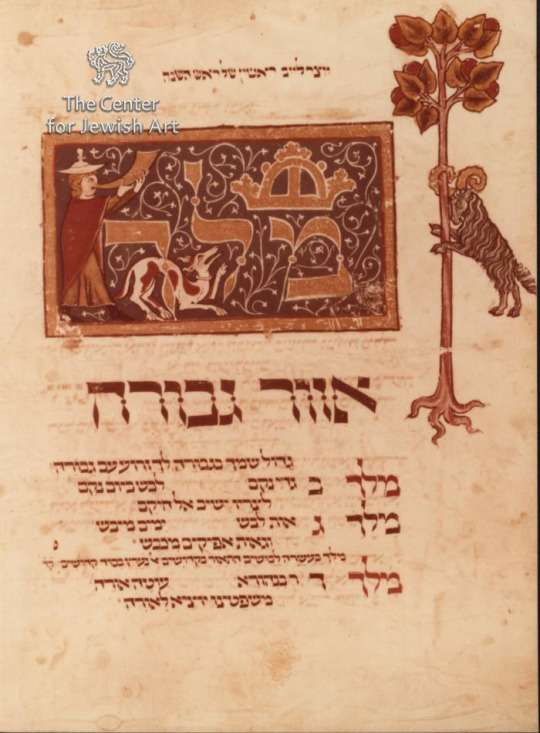
Mahzor from Worms, Germany; the name of the scribe is unknown.
6 notes
·
View notes
Text
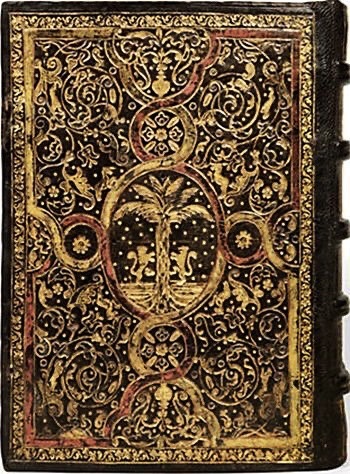
MAHZOR. (Tuscany, c1490) A Jewish holiday prayerbook. Gold highlights, initial word panels throughout in burnished gold on red, green or blue grounds, some embellished with marginal sprays, text illustrations Edges gilt and gauffered
Mid 16th-century Italian gold-tooled dark brown goatskin over thin wooden boards with strapwork painted in red and yellow, both covers with central cartouche with coat of arms, elaborately decorated with a unicorn and rabbit, hatched leaf and flower tools, solid dots and foliate rolls.
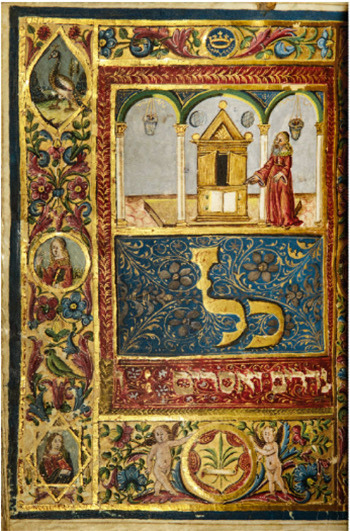
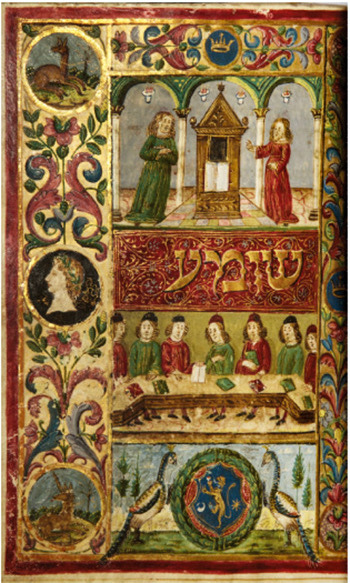
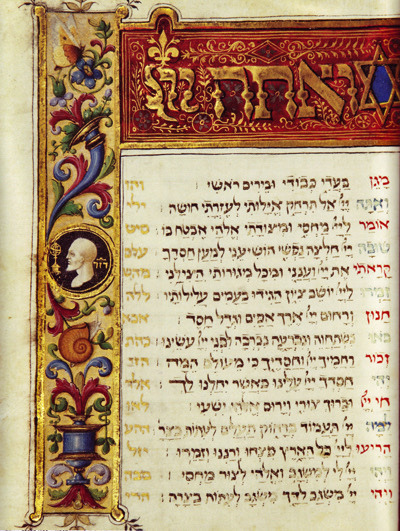

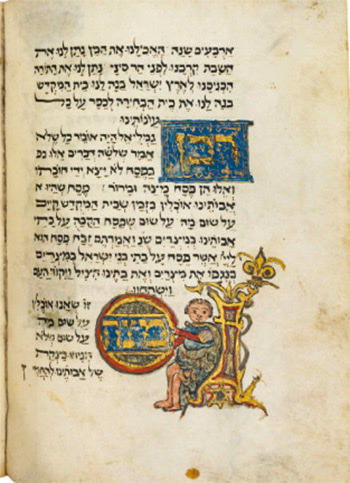
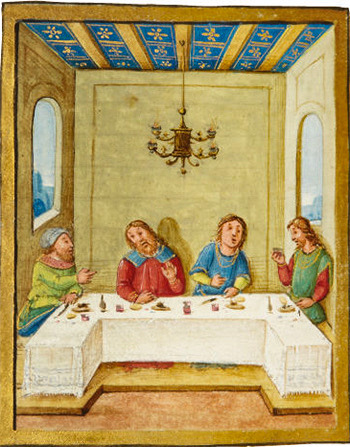
source
#beautiful books#book blog#books books books#book cover#books#vintage books#illustrated book#hebrew#mahzor#15th century#gauffered edges#illuminated manuscript#fore edge painting
58 notes
·
View notes
Text
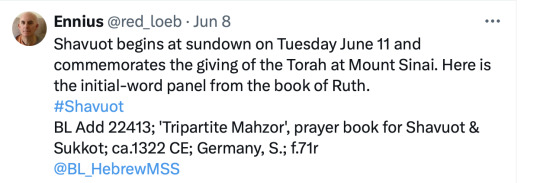

17 notes
·
View notes
Text
Rabbi: Inscribe us in the book of sustenance
Me, very impatient for the break fast to start: Please...I'm so hungry...
1 note
·
View note
Text
I have done a thing. More things will probably happen eventually. Not entirely satisfied, this isn't the hand I usually write in but it's the one most commonly in use in the period.


Inspiration taken from:
Mahzor for the Days of Awe and Taberacles, Western Ashkenazi Rite (Bodleian Library, MS. Bodley Or. 167)
Arba'ah Turim (Even ha-'ezer, Hoshen mishpat) (Bodleian Library, MS. Canonici Or. 79)
Repartorium iuris (Heidelberg University, Heid. Hs. 188)
The Wenceslas Bible - Digital Edition and Analysis
(yes, that Wenceslas - I picked it for a reason)
#kingdom come deliverance 2#kcd2#kcd2 fanart#illumination#I have done this many times for my favorite media#several of my friends have quotes on their walls now#because i have no chill#and no more wall space
14 notes
·
View notes
Text
When Putin invaded Ukraine I did not get an email in my inbox telling me the Homeland was in trouble and what I could do to help—Ukraine did not take it as a given that I, some 130 years removed from ancestral emigration from family line with over a century of settled citizenship in a different country, felt intrinsic kinship ties. Equally a few weeks ago when Parliament honoured a WWII Ukrainian war veteran, only to backpedal in a panic when they realized he'd served in the volunteer Ukrainian division of the Waffen-SS, nobody found me guilty by association when the discourse turned to a broader discussion of the realities of the Ukrainian alt-right.
But a couple days ago when Hamas breached the 6 billion dollar boondoggle of a border wall that imprisons Gaza, they didn't say they came to kill Israelis—a diverse group comprised of first-to-fourth generation immigrants from Europe, the Americas, and Africa; Mizrahim; Samaritans; Arabs; and Druze (among others). They just said they came to kill Jews. When Pro-Palestinian marches broke out in major cities, many had to be publicly reprimanded for their antisemitism: it wasn't a march against Israelis, it was a march against Jews. And when my rabbi sent out emails about supporting the 'Holy Land' it was to donate to an IDF Veterans charity because the IDF—the armed forces of the Middle Eastern nation-state of Israel of which I am not a citizen— have done 'so much for Jews worldwide.' I have never been to Israel. I have never had a desire to visit Israel, it being semi-arid, dry, and singularly uninviting place. Some 40 generations back the ancestors of my ancestors of my ancestors would have departed the region—perhaps after the loss of the Second Temple in the year 70, or the failure of the Bar Kokhba revolt in 132, or perhaps even further back, in one of the diasporas centuries before (over the last three thousand years most Jews have spent more time everywhere but Israel.) I am not an Israeli: not by birth, not by citizenship, not by any of the normal, standard criteria we culturally attach to immigrant status centuries upon centuries removed. But I want you to imagine if the United Kingdom got invaded tomorrow and you woke up to an e-mail asking you to support the Royal Marines because your ancestor was a charcoal burner outside of Londonium in the reign of Domitian.
I am not an Israeli, but the anti-Semites chanting in the streets and my rabbi treat me as functionally indivisible from one anyway. Consciously or unconsciously you probably do too. A Catholic might be asked to answer for the crimes of the Vatican, but a sixth generation Catholic from Boston isn't going to be asked to answer for the crimes of Spain—or Ireland, for that matter. But a 40-generation removed Jew cannot escape answering for Israel. You know, my great-grandfather lived through his Ukrainian relatives being slaughtered in a pogrom before the end of the first world war. His own Yiddish-speaking father never learned more than few words of English, had to go out of his way to have shabat and seders with the handful of other Jews who lived in Nowhere, Northern Ontario, but my great-grandfather became so afraid of his own Judaism that he threw himself into one of the stranger and more noxious Christian cults of the 19th century, one that would kill many of his children—and left it to his grandchildren and great-grandchildren to try and pick up the pieces puzzle-out why they had a last name that made Eastern Europeans frown when they heard it. He left us a diaspora within a diaspora within a diaspora, groping blind to find our way back to some kind of identity. It feels hard enough at times to accept the label of 'Jew' when you don't have a Hebrew name, when you mumble your way through a mahzor squinting at the phonetic prayers (acutely aware that you don't know the right times to sit or stand, much less bow), when your sense of lineage—your sense of tribe, of a past—ends in the burnt rubble of a synagogue on the banks of the Smotrych. It feel impossible, some days, to be a Jew simply within the framework of 'being a Jew,' whether you are practicing Judaism as a religion or go about your life with the genetic markers of ethnicity. It feels forever like there are so many ways to get it wrong, that it is all in some sense a performance that—if you fuck up even a little bit—you're diminishing Jews as effectively as any pogrom. The degree to which self-hating Jew as a term is weaponized is astounding, the degree to which 'being correctly Jewish' is a conscious act of will at times exhausting. I struggle to find my sense of place as a Jew, as a descendant of Jews, who were often hunted, slaughtered, oppressed, and extinguished. And to all this is added Israel, is added ethno-nationalism, is added the genocidal constitution of Hamas and the bombs and jet planes of the IDF. Three days ago Hamas committed mass-murder: a thousand dead, others kidnapped, children gunned down in the streets. In three days since the IDF has displaced over 230000 Gazans by bombing their homes, children blown-up in the streets. The street marchers shout 'death to Jews.' My rabbi wants me the beef-up the bombers pensions. All over a plot of land I have never visited and have no wish to see. This doesn't come to any kind of cathartic or intriguing rhetorical finale. I have no doubt it reads as nigh-incoherent. I've been writing it for hours, picking away at it, poking and prodding with an anguish I can't articulate. I sit here and write it on the knife-edge of privilege: I am not an Israeli under threat of a Hamas bullet, nor am I Gazan under threat of an IDF bomb. Yet the privilege is still a knife-edge, still a liminal state—because when we set-up for the Hanukah celebrations this winter, the police presence around us will be there for very different reasons than they were at the Santa Claus parade the week before. To be Jewish is already to live with conditional assimilation: I am not Israeli, I have no desire to be Israeli, O hold Israel and its policies against the Palestinians these past decades to be an incalculable injustice. Yet none of that matters to the white supremacist tomorrow who feels that now is the best time to kill some local Jews to preserve the purity of his ethno-state—because he's drawing on the biggest up-swell of antisemitic sentiment in a generation.
I am not an Israeli, I have no wish to be, and yet every Jew outside Israel the world over will still feel less safe tomorrow and in the days to come—because to the world at large, that doesn't matter.
6 notes
·
View notes
Note
So I haven't received it yet cuz shipping, but I ordered this one from Congregation Sha'ar Zahav because it was highly recommended!
https://shaarzahav.org/our-siddur/
I also discovered that Artscroll is currently giving away siddurim, including non-Ashki ones!
https://hashemlovesyou.net/
I also have and love Mishkan T'filah, and am currently waiting for my travel version to be delivered 😊
Thanks! I'll have to pass on the Sha'ar Zahav for now, it's awfully expensive and I just did a payment plan on my credit card for the Lev Shalem and the Mahzor Lev Shalem together. But I'd be interested to check that one out someday!
But I will take advantage of a free Siddur, if it's not inappropriate, I asked for a Nusach Edot haMizrach, because I would also like to have a Sfaradi perspective even if I'm 90% sure my congregation is Ashkenazi?
#jumblr#gerim#jew by choice#jewish convert#jewish#siddur#siddurim#tefillah#tefillot#ashkenazi#sephardic
5 notes
·
View notes
Text

Mahzor for the High Holidays, western Ashkenazi rite, c. 1320-1330.
Source: Bodleian Library, MS Michael 619, fol. 5v
265 notes
·
View notes
Text
Mahzor — Afghanistan, 1824 or 1825 CE

#jewish#judaism#jewish history#jewish art#religious objects#mahzor#afghani jews#swana jews#mizrahi jews
6 notes
·
View notes
Text


14 notes
·
View notes
Text
Rosh Hashshana 2023
Began at sunset
on Friday, Sept. 15,
and ends at sunset
on Sunday, Sept. 17.
No matter yours truly an atheist,
I consider myself
fascinated with my Semitic ancestry (maybe unwittingly genealogically linkedin with unsuspecting readers) excited regarding: upcoming Jewish holiday(s) fast approaching
by the bewitching hour,
which doth hold key to Chamber Of Secrets to – me analogous being Sorcerer's Apprentice tendering, and kindling Goblet of Fire as you will read and see, though impossible mission to proffer extensive family tree.
Courtesy of Google, this grown man
linkedin with tribes of Zion
indulged curiosity of mine
proudly harkens, (particularly
as he doth accumulate
orbitz around the sun)
from Semitic ancestral line
surrounded by Jewish community (countless years ago, when we called Penn Valley
our place of residence)
off a street that arched (like Noah’s bow sprint)
and named Woodbine.
Yet, he knows virtually nothing about Jewish History
lets inquisitiveness wander
as a descendent from
the “Lost Tribes Of Israel”
pondering how his life would be lived
if baptized in customs, faith, and religion
considered one of
the oldest codified paradigms.
The first of the High Holy Days
or Yamim Nora'im ("Days of Awe")
celebrated on the first two days of Tishrei
the first day of the
seventh month as "Zikhron Teru'ah"
("A memorial with the blowing of horns").
Rosh Hashanah is described
as "the day of judgment"
(Yom ha-Din) and
"the day of remembrance" (Yom ha-Zikkaron)
occurs 163 days
after the first day of Passover (Pesach)
beginning of Rosh Hashanah
at sundown at the end of 29 Elul.
The evening before
Rosh Hashanah day is known
as Erev Rosh Hashanah
("Rosh Hashanah eve").
On Rosh Hashanah day,
religious poems, called piyyuttim, are added to the regular services.
A special prayer book,
the Mahzor is used on Rosh Hashanah and Yom Kippur.
This sacred day,
the horn doth blow to then chauffeur
(two precious daughters now grown and autonomous
didst long since exit and escape
parental basket of deplorables,
where freedon beckoned,
when age of consent attained exited – rather hightailed out front door)
marginally linkedin with historical past
replete with tantalizing lore,
where legions of commandments pour
and more relevant than ever
as global tempests roar
atrocity diminishing Hebraic peoples
courtesy incessant pograms and war.
0 notes
Text
“Millions of Jews around the world will conclude the Passover seder this week with the traditional refrain “l’shana haba’ah b’Yerushalayim,” usually translated as “Next Year in Jerusalem!” (Literally, it means, “to the coming year, in Jerusalem.”) First attested in the Middle Ages, the phrase has become part of not only the Passover liturgy, but also the concluding service for Yom Kippur, and has long testified to the longing of the scattered Jewish people for a homeland where they could be free from persecution.
The reason for such a longing is obvious: Wherever they lived, Jews were almost always seen as an alien people, subject to special taxes, required to wear clothing that marked them as different, and often forced to convert to Christianity or Islam. According to Shulamit Elizur of the Hebrew University in Jerusalem, “l’shana haba’ah b’Yerushalayim” likely originated as an oral phrase, akin to “amen!” Pithy three-word phrases such as this were a common element of liturgical poetry and religious observance.
The first written occurrence, as “b’Yerushalayim, l’shana haba’ah,” occurs in a tenth-century poem by the Spanish rabbi Joseph ibn Abitur. The saying is found in its modern form the twelfth-thirteenth century Vitry Mahzor (High Holiday prayerbook), and the earliest occurrence in a Passover Haggadah is from the Bird’s Head Haggadah from c. 1300. The fifteenth-century Austrian rabbi Isaac Tyrnau writes of it being part of the Passover liturgy, and by the time of printed Haggadahs in the sixteenth century, it had become a standard formulation.”
6 notes
·
View notes
Photo
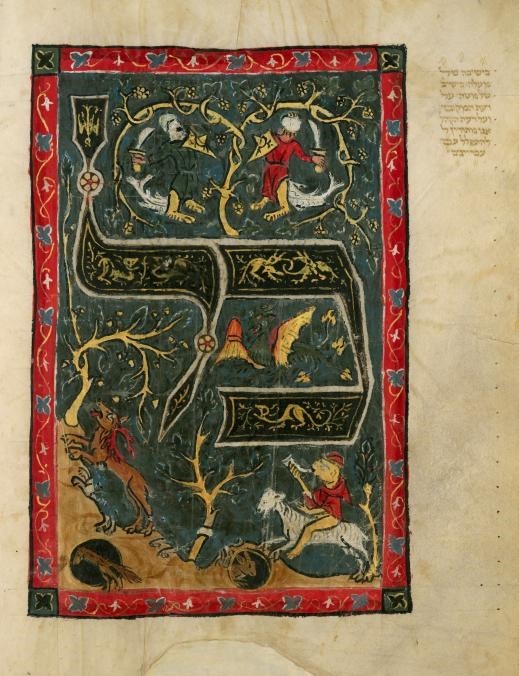
Kol nidre, initial word: כל (“All”) opening the Eve of Yom Kippur prayers from David bar Pesah Mahzor (Germany). Volume 2, 1301 - 1400 (Approximate), ink and watercolor on Vellum, From The New York Public Library.
#art#kol nidre#yom kippur#illuminated manuscript#Jewish Art#14th century#Hebrew#David bar Pesah Mahzor#manuscript#prayer book#jewish liturgy#codex#Ashkenazic script#mahzor#כל נידרי#גמר חתימה טובה#art history
681 notes
·
View notes
Photo

The Nuremberg Mahzor, according to the Eastern Ashkenazi rite, South Germany, 1331. Scribes: Mattanyah, Jacob.
Handwritten on parchment; brown and red ink, tempera, gold and silver leaf; square and semi-cursive Ashkenazic script
This illuminated prayer book for the entire year, in one massive volume, may have been used by the cantor in the synagogue. It includes the largest existing compilation of piyyutim with commentaries, many of these texts previously unknown. Commissioned by Joshua ben Isaac, the manuscript is a fine example of collaboration between different scribes and is decorated with 22 painted initial-word panels highlighted in gold and silver leaf, emphasizing the opening of some of the main prayers.
27 notes
·
View notes